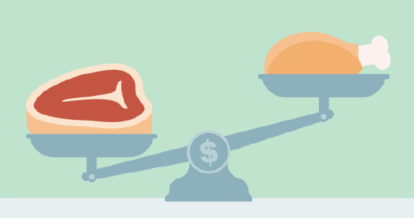Understatement of the year: Restaurant owners need to wear more than just a chef’s hat.
You need to be able to plan a menu, manage HR issues, execute a marketing plan, and understand your finances – from cash flow to contribution margins, and everything in between.
For many restaurateurs, finances are the hardest. After all, it’s a rare person who is both a phenom in the kitchen and an accounting wizard.
While you can hire an accountant to help keep you on track, it’s important to still have an understanding of things like cash flow, budgeting and forecasting, and profit margins. After all, you’re operating blindly without a good handle on the numbers.
One of the most important numbers to master is the cost of each dish on your menu. For many restaurant owners, this process is equal parts art, science, and shot in the dark.
That is, until they’re introduced to an accounting concept that can make the process a whole lot clearer – your contribution margin.
In this article, we’ll show you:
- What is contribution margin?
- How to calculate it
- How to use your contribution margin to assess and price your menu
Let’s dig in!

What Is Contribution Margin?
For restaurants, contribution margin is the measure of the profitability for an individual menu item. A different way of looking at profit, contribution margin is extra helpful when it comes to pricing individual menu items and thinking about the profitability of your menu as a whole.
When you consider this number alongside food cost percentage, you’ll be empowered to make precise pricing decisions that can take your restaurant to the next level.
Finding your contribution margin is the simple calculation of deducting the cost of the ingredients from your sell price:
Contribution Margin = Sell Price – Food Costs
For example, a steak sells for $45 and the cost of the ingredients is $25. The contribution margin is $20, your profit from the dish.
Important note: You may be wondering why you don’t factor in fixed costs, such as rent and utilities, in the contribution margin. After all, ingredients are technically only part of the cost that goes into every dish you make.
In this case, your contribution margin is a tool that only considers variable costs (i.e. ingredients). As Joe Knight, co-author of Financial Intelligence explained to Harvard Business Review, “contribution margin shows you the aggregate amount of revenue available after variable costs to cover fixed expenses and provide profit to the company.” He suggests looking at it as the portion of sales that helps offset fixed costs.
With that in mind, you can also use the contribution margin to help you set menu prices based on the amount of profit you want to make per customer. And when you find your overall menu contribution margin (the price of all menu items minus the cost of the ingredients), you can measure individual dishes against it to assess their performance.
But how does food cost percentage compare with contribution margin?
If you’ve been looking for ways to come up with a profitable price per dish in your restaurant, you’ve probably stumbled across food cost percentage. It is a handy way to assess and create a benchmark for pricing menu items.
Food Cost Percentage Per Dish = (Total Cost of Dish Per Serving / Price of Dish to Customer) x 100
For example, chicken a la king costs $6 to make. It sells for $20. To calculate the food cost percentage, let’s plug this into our formula.
Food Cost Percentage for Chicken = ($6/$20) x 100
= 0.3 x 100
= 30%
Therefore, the food cost percentage is 30%.
So, what should you be aiming for with your food cost percentage?
The current industry standard for food cost percentage is between 25% to 40% – but the lower you can get it the better.
Food cost percentage is a helpful calculation because it can give you a benchmark to use as you choose menu prices. Maybe you decide that you want all of your dishes to have a food cost percentage below 30%. Simply look at your menu prices and food cost and do a quick calculation – a dessert item that costs you $4.80 to make should be priced at $16 to achieve your goal. If you’re able to price it higher, you’ll get a lower food cost percentage and a higher profit margin.
Pro tip: You want your contribution margins to constantly be getting higher, while you want your food cost percentage getting lower.

Say your pasta primavera sells for $18.95 and only costs you $3.79 to make. Let’s look at the contribution margin and food cost percentage of this dish.
Food Cost Percentage = ($3.79/$18.95) x 100
= 0.2 x 100
= 20%
Contribution Margin = $18.95 – $3.79
= $15.16
A low food cost percentage and high contribution margin! That means this is a great dish to include on the menu, cost wise.
Now let’s look at a higher priced item. The seared cod has a sell price of $35 and costs you $10.50 to make. Let’s break down the food cost percentage and contribution margin again.
Food Cost Percentage = ($10.50/$35) x 100
= 0.3 x 100
= 30%
Contribution Margin = $35 – $10.50
= $24.50
At first glance, this looks like a less profitable dish because the food cost percentage is higher. But when you look at the contribution margin, you realize you’re making almost $10 more for every customer that orders the seared cod over the pasta primavera.
This is why doing the contribution margin math is a good exercise to pair with calculating food cost percentage.

Get this spreadsheet to better understand finances at your business.
What Can You Do with Your Menu to Boost Contribution Margins?
Once you know your contribution margins, the key is using this information.
Here are some ways to use this newfound number to make sure your menu is as profitable as possible.
Get Rid of Low-Performing Dishes
Once upon a time, guests loved your chef’s version of liver and onions. The contribution margin was just okay, but the dish was worth it because it was a fan favorite among the senior lawn bowling club that came in every week.
However, since the lawn bowling season ended, liver and onions has languished on the menu. With a low contribution margin and low sales, it no longer makes sense to keep it around. This is a good example of how volume of sales works hand in hand with contribution margin.
Identify Trends and Act on Them
Calculating the contribution margin is not a “one and done” exercise. Constantly checking the contribution margin against the number of sales is helpful to make note of food trends that you can use to your advantage.
For example, you may have been considering getting rid of an expensive steak tartare special your chef came up with because of its high food cost percentage and lower sales. But ever since you posted about it on Instagram, sales have gone way up! If you see people are responding to higher value items, it may be a good time to capitalize on that. Even with a higher food cost percentage, the lower contribution margin becomes worth it for the volume of sales (and new customers) an item is bringing in.
Fine-tune Dishes for Customer Satisfaction and Profit
Many chefs think of food integrity first, profit second. But why not consider both?
When putting together a new dish, play around with seasonal ingredients (like vegetables and other sides) to get the cost down. For example, switching out costly asparagus in the dead of winter for more affordable greens is an ideal way to get your contribution margin up with negligible effects on customer satisfaction.
Push Your Low Performing Items
When you’ve analyzed the contribution margin of all menu items, you may notice items with great contribution margins but not a lot of sales.
Consider pairing your poor performers with your all-star dishes, running limited-time specials, or even lowering the price temporarily to give them an opportunity to gain some traction. Maybe the more obscure menu items just need a chance to find their stride!
Redesign Your Menu
Want to give some shine to those dishes with great contribution margins? Redesign your menu to put them front and center where they belong. Encourage your servers to share “favorite” dishes with their customers to make them even more appealing.

Other Ways to Supercharge Your Contribution Margins
Selling more isn’t the only way to get your contribution margins as high as possible. Reducing the cost of ingredients and zeroing in on efficiency are surefire methods of changing the margin.
Here are some actions you can take:
Negotiate with Vendors
Is the cost of ingredients killing your contribution margin? Renegotiate with your vendors to see if you can get prices down. Sometimes discounts can be had by guaranteeing a certain volume or creating an exclusive partnership. It never hurts to review prices with vendors on a regular basis.
Reduce Waste
The cost of ingredients goes way up when some of it ends up in the compost. Many restaurant owners struggle to manage inventory, and most end up ordering too much. A good POS system will help you forecast labor, food, and other costs more efficiently so you’re not overstaffing or overordering and cutting into your profit margin.
Go All-in on Marketing
If you have dishes with strong contribution margins that aren’t getting the chance to add value, consider promoting them! Any dish can be a profit-maker if it sells enough.
Consider all the ways to get attention for your restaurant, including:
- Social media
- Flyers
- Specials, e.g. family nights, happy hour, seniors’ breakfast
- Loyalty rewards
Understanding contribution margin and how it works with food cost percentage can be a game-changer. When you make it part of your menu pricing, you’re equipped with more information that will help you get the profit your restaurant needs to succeed.
No more guesswork, taking a cue from other restaurants, or just keeping things the way they’ve always been. You can do the calculations that’ll empower you to make smart menu decisions moving forward.
Do the math!

Get this spreadsheet to better understand finances at your business.
Download our free inventory template
Sign up for our free weekly TouchBistro Newsletter







